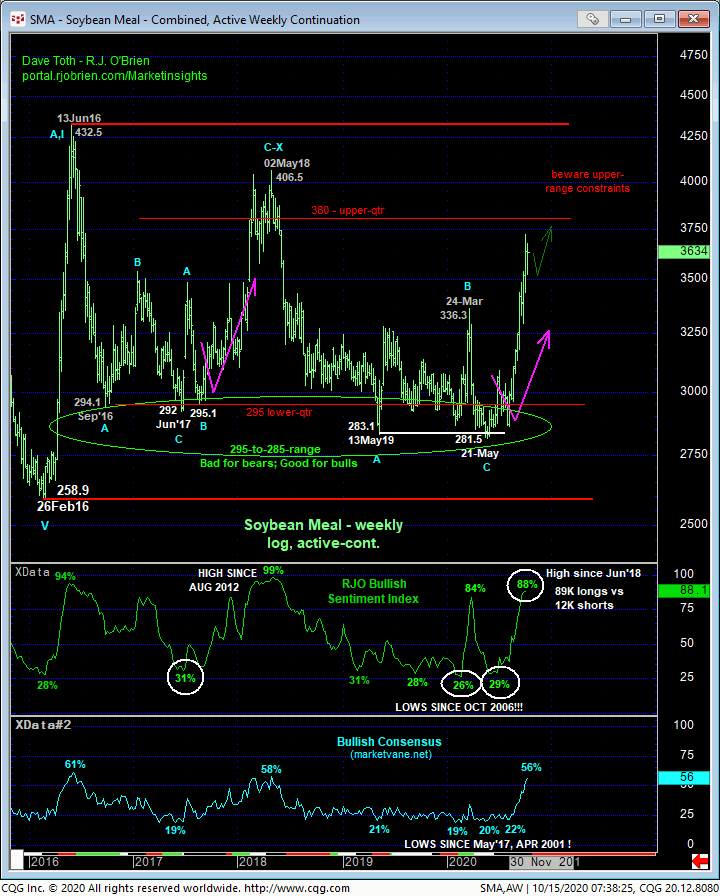
NOV SOYBEANS
As a result of the past couple days’ rebound, the market has identified Mon’s 10.31 low as one of developing, if short-term importance, the break of which could confirm a bearish divergence in daily momentum. Given the dramatic extent of this year’s reversal and understandable rush to the bull side by the huddled masses that have produced historically extreme bullish sentiment levels, we believe it’s appropriate to approach bull risk “up here” more conservatively. Per such, shorter-term traders with tighter risk profiles are advised to trail protective sell-stops on still-advised bullish policy and exposure to levels just below Mon’s 10.31 low and our new short-term risk parameter.


CLEARLY, looking at the magnitude of this year’s reversal higher, such smaller-degree weakness below a short-term level like 10.31 does not allow us to conclude a larger-degree reversal lower, but rather just an interim but perhaps deeper (4th-Wave) correction within a still-unfolding major 5-wave sequence up. However, given:
- clearly waning upside momentum on a daily basis above
- the prospect that 09-Oct’s 10.80 high completed a 5-wave Elliott sequence from 10-Aug’s 8.65 low as labeled above
- market sentiment that has reached frothy levels not seen since in at least 2-1/2-years and, in the case of our RJO Bullish Sentiment Index, since those that warned of and accompanied Mar’18’s major peak/reversal, and
- that the rally from 28-Apr’s 8.18 low spanned a length with 4-cents of its (10.76) 1.618 progression of May-Jul’19’s initial 7.91 – 9.37 rally,
we do not want to underestimate the extent to which this market might be vulnerable below 10.31, either as part of a larger-degree 4th-Wave correction that could easily retrace 38.2%-ish of Aug-Oct’s rally to the 9.92-area OR a more protracted reversal lower.
Indeed, on a broader daily or weekly basis, commensurately larger-degree weakness below 29-Sep’s 9.85 larger-degree corrective low remains required to, in fact, break even Aug-Oct’s (suspected 3rd-Wave) rally, let alone this year’s major reversal from Apr’s 8.37 low. Long-term commercial players remain advised to use this 9.85 low as our key long-term risk parameter to a bullish policy. But given the amount of green between 10.31 and 9.85, even longer-term players may want to exchange whipsaw risk (above 10.80) for deeper nominal risk (below 9.85) if the market relapses below 10.31.
These issues considered, a bullish policy and exposure remain advised with a failure below 10.31 required to defer or threaten a bullish count enough for shorter-term traders to step aside and for longer-term players to pare exposure to more conservative levels. Commensurately larger-degree weakness below 9.85 remains required for long-term players to jettison remaining exposure altogether to circumvent the depths unknown of either a larger-degree 4th-Wave correction within the still-unfolding major bull trend OR a major reversal lower. Needless to say, a recovery above 10.80 mitigates all this peak/correction/reversal stuff, reinstates the bull and exposes potentially extensive gains thereafter.

DEC SOYBEAN MEAL

The technical construct of the meal market is identical to that detailed above in beans with 352.3 and 329.7 considered our short- and long-term risk parameters around which traders are advised to rebase and manage the risk of a still-advised bullish policy and exposure.



